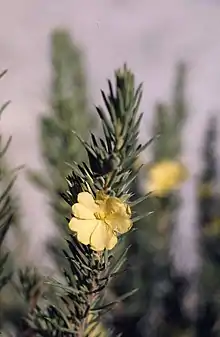Hibbertia mucronata
Hibbertia mucronata is a species of flowering plant in the family Dilleniaceae and is endemic to the south of Western Australia. It is an erect shrub with hairy branches, crowded, thick, tapering linear leaves ending in a sharp point, and golden yellow flowers with five stamens fused at their bases, all on one side of two densely hairy carpels.
| Prickly hibbertia | |
|---|---|
 | |
| Scientific classification | |
| Kingdom: | Plantae |
| Clade: | Tracheophytes |
| Clade: | Angiosperms |
| Clade: | Eudicots |
| Order: | Dilleniales |
| Family: | Dilleniaceae |
| Genus: | Hibbertia |
| Species: | H. mucronata |
| Binomial name | |
| Hibbertia mucronata | |
Description
Hibbertia mucronata is an shrub that typically grows to a height of up to 1 m (3 ft 3 in) and has woolly-hairy branchlets. The leaves are crowded, spirally arranged, thick, linear tapering to a sharp point, 5–18 mm (0.20–0.71 in) long and 0.9–1.5 mm (0.035–0.059 in) wide on a petiole 1.0–1.5 mm (0.039–0.059 in) long. The flowers are arranged singly in leaf axils and more or less sessile or on a hairy peduncle up to 2 mm (0.079 in) long, sometimes with sharply-pointed bracts at the base. The five sepals are joined at the base, the outer sepals 6.0–8.5 mm (0.24–0.33 in) long, the inner ones 5–5.5 mm (0.20–0.22 in) long. The five petals are golden yellow, egg-shaped with the narrower end towards the base and 6–9 mm (0.24–0.35 in) long with a notch at the tip. There are five stamens, fused at the base on one side of the two densely hairy carpels that each contain two ovules. Flowering mostly occurs between August and December.[2][3]
Taxonomy
Hibbertia mucronata was first formally described in 1852 by Nikolai Turczaninow who gave it the name Pleurandra mucronata in Bulletin de la Société Impériale des Naturalistes de Moscou.[4][5] In 1863 George Bentham changed the name to Hibbertia mucronata in Flora Australiensis.[6][7] The specific epithet (mucronata) means "mucronate", referring to the leaves.[8]
Distribution and habitat
This species grows in rocky places or in sandy heath or mallee-scrub in the Fitzgerald River National Park and east to Ravensthorpe and Hopetoun in the south of Western Australia.[2][3]
Conservation status
Hibbertia mucronata is classified as "not threatened" by the Western Australian Government Department of Parks and Wildlife.
See also
References
- "Hibbertia mucronata". Australian Plant Census. Retrieved 21 July 2021.
- Wheeler, Judith R. (2000). "Review of Hibbertia mucronata and its allies (Dilleniaceae)". Nuytsia. 13 (2): 381–382. Retrieved 21 July 2021.
- "Hibbertia mucronata". FloraBase. Western Australian Government Department of Biodiversity, Conservation and Attractions.
- Turczaninow, Nikolai (1852). "Pleurandra mucronata". Bulletin de la Société Impériale des Naturalistes de Moscou. 25 (3): 139–140. Retrieved 21 July 2021.
- "Pleurandra mucronata". APNI. Retrieved 21 July 2021.
- "Hibbertia mucronata". APNI. Retrieved 21 July 2021.
- Bentham, George; von Mueller, Ferdinand (1863). Flora Australiensis. London: Lovell Reeve & Co. p. 29. Retrieved 21 July 2021.
- Sharr, Francis Aubi; George, Alex (2019). Western Australian Plant Names and Their Meanings (3rd ed.). Kardinya, WA: Four Gables Press. p. 256. ISBN 9780958034180.